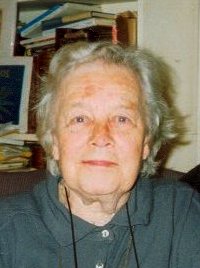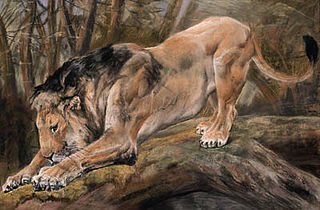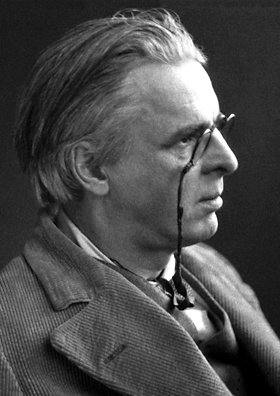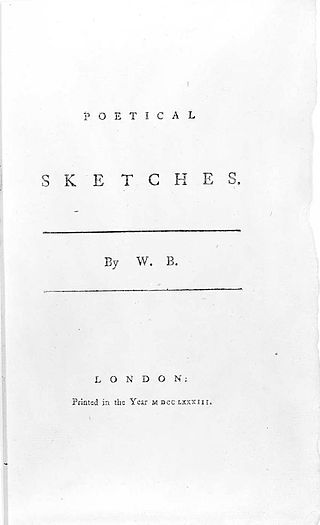
William Blake was an English poet, painter, and printmaker. Largely unrecognised during his life, Blake is now considered a seminal figure in the history of the poetry and visual art of the Romantic Age. What he called his "prophetic works" were said by 20th-century critic Northrop Frye to form "what is in proportion to its merits the least read body of poetry in the English language". While he lived in London his entire life, except for three years spent in Felpham, he produced a diverse and symbolically rich collection of works, which embraced the imagination as "the body of God" or "human existence itself".

William Butler Yeats was an Irish poet, dramatist and writer, and one of the foremost figures of 20th-century literature. He was a driving force behind the Irish Literary Revival, and along with Lady Gregory founded the Abbey Theatre, serving as its chief during its early years. He was awarded the 1923 Nobel Prize in Literature, and later served two terms as a Senator of the Irish Free State.

Thomas Sturge Moore was a British poet, author and artist.

Kathleen Jessie Raine was a British poet, critic and scholar, writing in particular on William Blake, W. B. Yeats and Thomas Taylor. Known for her interest in various forms of spirituality, most prominently Platonism and Neoplatonism, she was a founding member of the Temenos Academy.

Edwin John Ellis (1848–1916) was a British poet and illustrator. He is now remembered mostly for the three-volume collection of the works of William Blake he edited with W. B. Yeats. It is now criticised, however, for weak scholarship, and preconceptions.
The Tower is a book of poems by W. B. Yeats, published in 1928. The Tower was Yeats's first major collection as Nobel Laureate after receiving the Nobel Prize in 1923. It is considered to be one of the poet's most influential volumes and was well received by the public.
— Opening lines from The Waste Land by T. S. Eliot, first published this year

The prophetic books of the 18th-century English poet and artist William Blake are a series of lengthy, interrelated poetic works drawing upon Blake's own personal mythology. They have been described as forming "what is in proportion to its merits the least read body of poetry in the English language". While Blake worked as a commercial illustrator, these books were ones that he produced, with his own engravings, as an extended and largely private project.

John Trivett Nettleship was a British artist, known as a painter of animals and in particular lions. He was also an author and book illustrator.
—From A Prayer for My Daughter by W. B. Yeats, written on the birth of his daughter Anne on February 26
Nationality words link to articles with information on the nation's poetry or literature.
This is a list of all works by Irish poet and dramatist W. B. Yeats (1865–1939), winner of the 1923 Nobel Prize in Literature and a major figure in 20th-century literature. Works sometimes appear twice if parts of new editions or significantly revised. Posthumous editions are also included if they are the first publication of a new or significantly revised work. Years are linked to corresponding "year in poetry" articles for works of poetry, and "year in literature" articles for other works.
A Vision: An Explanation of Life Founded upon the Writings of Giraldus and upon Certain Doctrines Attributed to Kusta Ben Luka, privately published in 1925, is a book-length study of various philosophical, historical, astrological, and poetic topics by the Irish poet William Butler Yeats. Yeats wrote this work while experimenting with automatic writing with his wife Georgie Hyde-Lees. It serves as a meditation on the relationships between imagination, history, and the occult. A Vision has been compared to Eureka: A Prose Poem, the final major work of Edgar Allan Poe.

Vala, or The Four Zoas is one of the uncompleted prophetic books by the English poet William Blake, begun in 1797. The eponymous main characters of the book are the Four Zoas, who were created by the fall of Albion in Blake's mythology. It consists of nine books, referred to as "nights". These outline the interactions of the Zoas, their fallen forms and their Emanations. Blake intended the book to be a summation of his mythic universe but, dissatisfied, he abandoned the effort in 1807, leaving the poem in a rough draft and its engraving unfinished. The text of the poem was first published, with only a small portion of the accompanying illustrations, in 1893, by the Irish poet W. B. Yeats and his collaborator, the English writer and poet Edwin John Ellis, in their three-volume book The Works of William Blake.

"The Circus Animals' Desertion" is a poem by William Butler Yeats published in Last Poems in 1939. While the original composition date of the poem is unknown, it was probably written between November 1937 and September 1938. In the preface, Yeats suggests that he intended the poem to combine his personal views and impressions with the customs and beliefs of Christian Ireland. The poem was the last work published in Yeats's final collection, with "Politics" following as an envoi. In the poem, the poet uses the desertion of circus animals as an analogy to describe his failure to find inspiration for poetic creation as he seeks for new inspiration. Critics have detected aspects of both Modernism and Postmodern literature in the poem.
David V. Erdman was an American literary critic, editor, and Professor Emeritus of English at the State University of New York at Stony Brook. Professor Erdman established his reputation as a William Blake scholar.

Poetical Sketches is the first collection of poetry and prose by William Blake, written between 1769 and 1777. Forty copies were printed in 1783 with the help of Blake's friends, the artist John Flaxman and the Reverend Anthony Stephen Mathew, at the request of his wife Harriet Mathew. The book was never published for the public, with copies instead given as gifts to friends of the author and other interested parties. Of the forty copies, fourteen were accounted for at the time of Geoffrey Keynes' census in 1921. A further eight copies had been discovered by the time of Keynes' The Complete Writings of William Blake in 1957. In March 2011, a previously unrecorded copy was sold at auction in London for £72,000.

The Life of William Blake, "Pictor Ignotus." With selections from his poems and other writings is a two-volume work on the English painter and poet William Blake, first published in 1863. The first volume is a biography and the second a compilation of Blake's poetry, prose, artwork and illustrated manuscript.

All Religions are One is a series of philosophical aphorisms by William Blake, written in 1788. Following on from his initial experiments with relief etching in the non-textual The Approach of Doom (1787), All Religions are One and There is No Natural Religion represent Blake's first successful attempt to combine image and text via relief etching, and are thus the earliest of his illuminated manuscripts. As such, they serve as a significant milestone in Blake's career; as Peter Ackroyd points out, "his newly invented form now changed the nature of his expression. It had enlarged his range; with relief etching, the words inscribed like those of God upon the tables of law, Blake could acquire a new role."

The Notebook of William Blake was used by William Blake as a commonplace book from c. 1787 to 1818.













